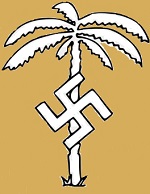Dragon DRR61001 German Early Production Sd. Kfz. 181 PzKpfw VI Tiger I Heavy Tank - "White 142", schwere Panzerabteilung 501, Tunisia, 1942 (1:35 Scale)
"The gun and armor of the Tiger were superb, making it in many ways the most formidable tank in service. Even so, it was poor in maneuver, it was slow, and its turret was a slow traverser in action. It was a tank which was, at its best, immobile in ambush, when its killing power was very frightening."
- Douglas Orgill, "German Armor"
 The German Waffenamt issued an order to design the VK4501(H) (as the PzKpfw VI Ausf. E was then known) in May 1941, just one month prior to the commencement of Operation Barbarossa. Interestingly, Henschel und Sohn of Kassel was charged with building the heavily armored chassis while Krupp, by far the largest munitionwerks in Germany, was given the task of developing the turret. The PzKpfw VI Ausfuhrung E (type E) was one of the first German tanks to feature a torsion bar with eight interleaved wheels, which was designed to support the weight of the mammoth 57-ton tank. The Ausf. E mounted a huge 8.8cm KwK36 L/56 cannon and featured two MG34 machine guns for close support against enemy infantry.
The German Waffenamt issued an order to design the VK4501(H) (as the PzKpfw VI Ausf. E was then known) in May 1941, just one month prior to the commencement of Operation Barbarossa. Interestingly, Henschel und Sohn of Kassel was charged with building the heavily armored chassis while Krupp, by far the largest munitionwerks in Germany, was given the task of developing the turret. The PzKpfw VI Ausfuhrung E (type E) was one of the first German tanks to feature a torsion bar with eight interleaved wheels, which was designed to support the weight of the mammoth 57-ton tank. The Ausf. E mounted a huge 8.8cm KwK36 L/56 cannon and featured two MG34 machine guns for close support against enemy infantry.
By war's end, 1,354 vehicles had been produced, some rolling off the Wegmann assembly line.
This particular 1:35 scale early version Tiger is painted in a desert sand scheme and was attached to schwere Panzerabteilung 501, then operating in Tunisia during late 1942. Composed of both diecast metal and plastic, this superb replica features opening hatches, rotating turret, moveable guns and static tracks. Comes with plastic display base.
Sold Out!
Dimensions:
Length: 10-inches
Width: 4-inches
Height: 4-inches
Release Date: January 2006
Historical Account: "Cast in the Shadows" - Tunisia was the scene of the first major joint operations between the United States and British allies in World War II during 1942-1943. The main body of the British army, advancing from their victory at the Battle of El-Alamein under the command of British Field Marshal Montgomery, pushed into Tunisia from the south whereas the US and other allies, following their invasions of Algeria and Morocco in Operation Torch, came from the west. With Germany engaged in the battle of Stalingrad, it is easy to dismiss the battle for Tunisia as a minor event, but in fact it had significance for the rest of the war.
General Erwin Rommel, commander of Axis forces in North Africa, had hoped to inflict a similar defeat on the allies in Tunisia as the German forces had in the Battle of France in 1940.
Until the battle for Tunisia, the inexperienced allied forces had generally been unable to withstand quick German blitzkriegs or properly coordinate their operations, therefore the battle for Tunisia was a major test of the allies. If they were going to defeat Germany they were going to have to fight together, and stand up to the inevitable setbacks that the excellent German forces would inflict.
On February 19th, 1943, General Rommel launched an attack on the American forces in the Kasserine Pass region of Western Tunisia, hoping to inflict the kind of alliance and morale shattering defeat the Germans had won in Poland and France. The initial results were a disaster for the United States; to this day the area around the Kasserine Pass is the site of many US war graves from that time.
However, the American forces were ultimately able to stop their retreat, having learned a critical lesson in tank warfare. On March 20th, 1943, the Allies broke through the German Mareth line and subsequently linked up on April 8th, 1943. Thus, the alliance of the United States, the United Kingdom, the Free French, and Polish as well as other forces were able to win a major battle as an allied army.
The battle, though often overshadowed by Stalingrad, represented a major allied victory of World War II largely because it forged the Alliance which would one day liberate Western Europe.


